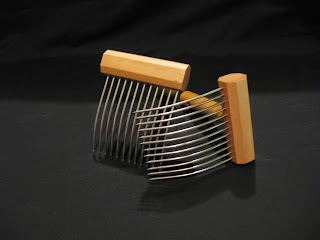 |
| Wool Yarn Dyed With Natural Dyes |
Moving along in our series of articles on Natural Dyes, and into the yellows, Weld , Reseda luteola, is one of the most historically important of the yellow natural dyes.
 |
| Wool Yarn Dyed with Weld, Mordant: Tin |
Also know as dyer's rocket, dyer's weed, and yellow weed, Weld is a native of Eurasia.
It was in use as a dye by the first century B.C. and was introduced to North America by the Colonists.
It not only produces a beautiful butter yellow colors, but was also in over dyeing with indigo or woad to produce a color fast green. Because good greens are hard to produce using natural dyes, Weld became one of the most important dyes in the production of this color.
Grown from seeds, the thin long leaves grow from a rosette and the plant produces a spike for it's flower.
Even though it is considered an annual, but by accident, we were able to keep our Weld plants surviving the winter by planting them next to our clothes dryer vent.
They died off after the frost in the fall, but emerged from the roots the next spring.
These plants have lasted 3 summers and produced good dye material.
 |
| Weld Plants |
The whole plant above the ground is used as a dye.
It can be used fresh or dried.
Simply tie a plant bundle with string and boil it in water to extract the dye.
If you are using chopped plant material, fashion a cloth tea bag , place the chopped material in the bag, tie tightly, and boil in water to extract the dye.
 |
| Dried Chopped Weld |
As with all natural dyes, the color will depend on the strength of the dye bath, the ph of the water, and the mordant that is used.
 | |||||||
| Wool Yarn Dyed with Weld, Mordants Left to Right: Alum, Tin, Iron |
Dried Chopped Weld is available on our website, along with other natural dyes, mordants, and wool yarn dyed with natural dyes.
When available, we also may have wool roving dyed with natural dyes and natural dye plant seeds.
© 2015 Brush Creek Wool Works










